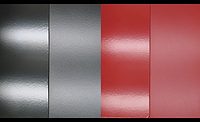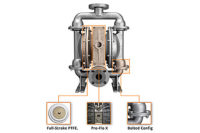
UV/EB-cure technology offers increased productivity, lower energy consumption and environmental advantages.1 Therefore, formulators and end-users prefer formulation systems based on UV/EB-curable systems compared to conventional water- or solvent-based technologies as evidenced by their increasing use in coatings, inks and adhesive applications. The growth in the number of applications and the variety of substrates, such as thermoplastic polyolefins (TPO) in automotive and metallized plastics in mobile handsets, requires UV-curable formulations to possess special properties for specific end-uses.2,3 First, some basic definitions are in order.
Wetting - the process by which a liquid coating displaces air at the air-substrate interface.
Flow - the motion of the coating on a substrate during and after wetting.
Leveling - the surface aspect of the coating after wetting and before curing.
Dispersion stability - ability of a dispersant to wet out pigment and keep pigment particles from agglomeration and prevent settling.
Pseudoplasticity and Thixotropy - Pseudoplastic is shear-dependent viscoelastic flow. This is seen as a reduction in viscosity with increasing shear rate. A material is thixotropic when, in addition to shear strain rate, there is time-dependent response, i.e., an ink's viscosity changes with time even after shear forces are removed.4
Substrate wetting and flow are important for all coatings to ensure good protective functions (good adhesion, resistance to ingress of moisture and other environmental agents) and aesthetic appeal (smooth surface appearance). Typical problems encountered due to poor wetting are cratering or crawling and fisheye-like appearance on portions of the coatings (Figure 1).
Poor flow and leveling and high coating viscosity can occur due to sub-optimal pigment dispersion. Improper pigment stabilization can result in agglomeration, and settling can lower coating gloss. In filled topcoats, one encounters increased thixotropy, which creates problems during the application process and reduces surface appeal. Finally, poor flow and leveling can cause an "orange peel"-like effect (Figure1), produce surfaces that are harder to sand evenly and create poor surface appearance. This is especially true for fast-curing UV/EB coatings if curing line speeds are so high that the coating does not fully flow and level out prior to cure, after which time, the morphology of the coating is "frozen" or irreversible due to rapid crosslinking. Using four examples we evaluated how formulators tackle these issues in practice.

Contact Angle
Contact angle measurements were done using a Ramie-Hart Goniometer at 25 °C. All measurements were made by placing a single drop of material on a Teflon substrate. The dynamic surface tension of the different UV acrylates was measured at 25 °C using a Krüss maximum bubble pressure tensiometer BP 2, in combination with a BPC2 capillary and BP23 software.
Viscosity
The viscosity of all monomers was measured using a Brookfield DVII Plus viscometer at 25 °C.
Rheology
The apparent viscosity of the inks was measured using a Bohlin-Rheometer RVO at 25 °C using an oscillatory shear strain rate range of 0.1 to 1000 s-1.
Curing Conditions
All coatings were cured as noted in the tables provided for the formulations in the results and discussion section.
Gloss
Gloss measurements were made using a BYK Gardner Micro-Tri-Gloss meter. All gloss readings were taken at 60°.
Materials
All starting materials unless otherwise noted were obtained from Cognis Corporation (Table 1).

Case I - Clear Coat on Tin Metal
This formulation refers to a coating on untreated or "oily" tin metal. The requirement in this case was a UV-curable coating of sprayable viscosity for tin metal without a pre-treat cleaning step which, after cure, had good adhesion to metal and excellent surface appearance. Optimum substrate wetting is very important for all industrial-coating processes. For best substrate wetting, the contact angle made by the coating onto the substrate, should be as low as possible (Figure 2).
In other words, the surface tension of the liquid coating should be lower than the surface energy of the substrate to be coated. A typical way of achieving this is to treat the substrate with plasma, corona or flame (usually applied to plastics) or other chemical treatments (usually applied to metals) to clean and increase the surface energy of the substrate. This was not an option in our case. So we chose an alternative, i.e., to reduce the surface tension of the coating formulation.


Two monomers, NPG(2PO)DA and NPG(2PO)-OMe monoacrylate, were used in identical amounts in the sprayable formulation (Table 3). The surface aspect of the two formulations is shown in Figure 4. The formulation containing the monomer NPG(2PO)-OMe monoacrylate with the lowest contact angle and surface tension shows excellent coating coverage and surface smoothness. There is considerable "crawling" or withdrawal of coating of the formulation containing NPG(2PO)DA. The only structural difference between these monomers is a single methyl ether group.

Further, the rise in dynamic surface tension over three orders of magnitude of bubble frequency is much smaller for NPG(2PO)-OMe acrylate versus NPG(2PO)DA. Bubble frequency is a proxy for rapidity of change of surfaces. This means that the methylether acrylate containing formulation is better able to maintain lower surface tension and wet out the "oily" metal surface as it undergoes very rapid and dynamic changes in its surface environment during the coating application process prior to UV curing of the coating.

In this formulation (Table 4), the requirement was for a clearcoat with good reactivity and low blocking resistance. Two formulations were used. The only difference was that formulation B lacked an acrylated polysiloxane block copolymer additive. As a class, silicone-based surfactants are known to have among the lowest surface tension after fluorinated polyols. The no-overcoat requirement meant that we could use a silicone surfactant without worrying about intercoat adhesion issues encountered in multilayer UV coatings when the undercoat has silicone surface modifiers. Further, on curing, an acrylated silicone is incorporated randomly throughout the topcoat, allowing for more control of slip properties and reduced blocking as evidenced from a lower slide angle and lower block resistance for the cured topcoat.
Case III - UV-Curable Flexographic Ink on Polyester Film
The requirements for this application were: low and stable viscosity profile on the UV flexographic press, good pigment dispersion stability, good substrate wetting to PET and high gloss after cure. Non-homogenous systems like UV flexographic inks can present significant flow problems on a flexographic press. Typical symptoms such as high viscosity, poor ink flow across the roller train (the metering roll, fountain roll, the anilox and the impression cylinder), poor ink transfer to substrate and sub-par color and print quality. These can be minimized using: a) properly equipped roller train and b) UV flexographic inks with well-chosen dispersants that wet out and stabilize the pigment.

In contrast to water-based flexographic inks, UV-curable inks are expected to have high gloss and possess better chemical resistance due to their highly crosslinked nature. A dramatic 25-point improvement in cured ink gloss (Figure 7) is also seen in the dispersant-stabilized UV ink, also implying the better pigment wet out by the binder in the dispersant-containing ink.

The requirement for this coating was a low-gloss, matte aspect for a wood finish. The coating was applied using a roll coater and needed excellent de-airing prior to cure to prevent pinholes and other defects that might produce reject parts due to a poor aesthetic surface. Table 6 shows the formulation used in this application. The control formulation did not contain the polyurethane polymer dispersant.


The best choices to solve issues relating to flow and leveling challenges depend on the intended goal. If the goal is to get good wet out of low-energy substrates, a combination of substrate surface treatment and the use of low-viscosity, UV-curable, low-surface-tension monomers (i.e., neopentylglycol (2PO) monomethyl ether acrylate) should help in coating wet out, flow and leveling. These monomers tend to have low substrate contact angles and are particularly useful in primers or undercoats. In contrast, for topcoats, either block copolymer silicones or acrylated polysiloxane copolymers can be used to reduce coating surface tension. Better control of slip and block is expected from the acrylated silicones. To get optimum in-storage, in-use and after-cure application performance in pigmented (organic or inorganic) systems, well-chosen polymeric (polyurethane) dispersants can produce dramatic changes in pigment wetting, dispersion stability and gloss control at low (3-5%) incorporation levels.
Acknowledgements
The authors thank Mr. Levi Scott of Cognis Corporation for his help in preparing this article.
For further information, please contact Dr. Anbu Natesh: anbu.natesh@cognis.com




Report Abusive Comment